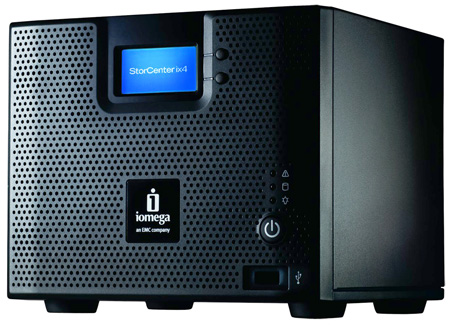

With a mixture of enterprise- and consumer-oriented features and a target audience of small and remote branch offices, Iomega’s StorCenter ix4-200d network-attached storage device has something of a dual personality. The device turns in solid performances in each of its roles, and as a result can be useful in ways that other products aren’t.
On the one hand, the unit sports a collection of consumer-friendly features that allow it to appear on a network as a media server visible to iTunes, network-capable Blu-ray players and television sets. For instance, I tapped its support for the relatively new DLNA standard and was able to browse photo files using a Droid X from Verizon Wireless.
On the other hand, the ix4-200d boasts enterprise features such as dual Gigabit Ethernet ports, RAID 5 protection and iSCSI support. It lacks the performance, power and cooling characteristics necessary to earn a spot in your data centre, but can serve well as a file, print or media server and is well suited as a shared storage device for test lab virtualisation hosts.
The StorCenter ix4-200d first shipped in 2009 but received an April firmware update bringing improvements in performance, iSCSI operations, Active Directory integration and RAID performance. It’s currently priced at £880.08 for 4TB of storage, with a 2TB model for £633.33 and an 8TB model for £1,291.33.
The ix4-200d is about as close to plug and play as storage can get. When I set the device up, about all I had to do was plug in the power and network cables. You can give it a name if you wish, and you can assign a fixed IP address, but you don’t need to do either — the unit works fine with DHCP (Dynamic Host Configuration Protocol) networking.
Once I got the device attached and running, which only took a couple of minutes, I had a significant number of options, all of which were configurable using the included StorCenter software. The management software enabled me to create users and assign them personal directories, set up workstation backup scenarios, add USB or network-based storage and create iSCSI target drives.
As an NAS device, the ix4-200d proved easily discoverable by client workstations. Once I set up my workstations to see it and assigned drive letters where appropriate, the device performed just like any other network storage device. In this sense, it’s an inexpensive way to add a few extra terabytes to your network in a hurry.
Page: 1 2
Apple fined 150m euros over App Tracking Transparency feature that it says abuses Apple's market…
OpenAI to release customisable open-weight model in coming months as it faces pressure from open-source…
Samsung's Bespoke AI-powered fridge monitors food to create shopping lists, displays TikTok videos, locates misplaced…
Huawei sees 38 percent jump in consumer revenues as its smartphone comeback continues to gather…
In world-first, China approves commercial flights for EHang autonomous passenger drone, paving way for imminent…
Microsoft closes down IoT and AI lab it operated in Shanghai tech district in latest…